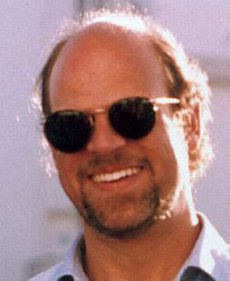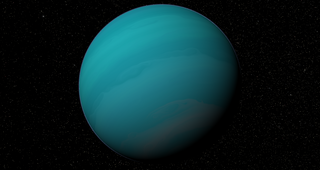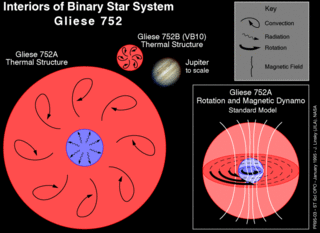
Lalande 21185 is a star in the south of Ursa Major. It is the apparent brightest red dwarf in the northern hemisphere. Despite this, and being relatively close by, it is very dim, being only magnitude 7.5 in visible light and thus too faint to be seen with the unaided eye. The star is visible through a small telescope or binoculars.

The Lick Observatory is an astronomical observatory owned and operated by the University of California. It is on the summit of Mount Hamilton, in the Diablo Range just east of San Jose, California, United States. The observatory is managed by the University of California Observatories, with headquarters on the University of California, Santa Cruz campus, where its scientific staff moved in the mid-1960s. It is named after James Lick.

Michel Gustave Édouard Mayor is a Swiss astrophysicist and professor emeritus at the University of Geneva's Department of Astronomy. He formally retired in 2007, but remains active as a researcher at the Observatory of Geneva. He is co-laureate of the 2019 Nobel Prize in Physics along with Jim Peebles and Didier Queloz, and the winner of the 2010 Viktor Ambartsumian International Prize and the 2015 Kyoto Prize.

Geoffrey William Marcy is an American astronomer. He was an early influence in the field of exoplanet detection, discovery, and characterization. Marcy was a professor of astronomy at the University of California, Berkeley, and an adjunct professor of physics and astronomy at San Francisco State University. Marcy and his research teams discovered many extrasolar planets, including 70 out of the first 100 known exoplanets and also the first planetary system around a Sun-like star, Upsilon Andromedae. Marcy was a co-investigator on the NASA Kepler mission. His collaborators have included R. Paul Butler, Debra Fischer and Steven S. Vogt, Jason Wright, Andrew Howard, Katie Peek, John Johnson, Erik Petigura, Lauren Weiss, Lea Hirsch and the Kepler Science Team. Following an investigation for sexual harassment in 2015, Marcy resigned his position at the University of California, Berkeley.

Robert Paul Butler is an astronomer and staff scientist at the Carnegie Institution for Science in Washington, D.C., who searches for extrasolar planets.

Gliese 876 is a red dwarf star 15.2 light-years away from Earth in the constellation of Aquarius. It is one of the closest known stars to the Sun confirmed to possess a planetary system with more than two planets, after GJ 1061, YZ Ceti, Tau Ceti, and Wolf 1061; as of 2018, four extrasolar planets have been found to orbit the star. The planetary system is also notable for the orbital properties of its planets. It is the only known system of orbital companions to exhibit a near-triple conjunction in the rare phenomenon of Laplace resonance. It is also the first extrasolar system around a normal star with measured coplanarity. While planets b and c are located in the system's habitable zone, they are giant planets believed to be analogous to Jupiter.
Gliese 581 is a red dwarf star of spectral type M3V at the center of the Gliese 581 planetary system, about 20.5 light years away from Earth in the Libra constellation. Its estimated mass is about a third of that of the Sun, and it is the 101st closest known star system to the Sun. Gliese 581 is one of the oldest, least active M dwarfs known. Its low stellar activity improves the likelihood of its planets retaining significant atmospheres, and lessens the sterilizing impact of stellar flares.

Gliese 667 is a triple-star system in the constellation Scorpius lying at a distance of about 7.2 parsecs from Earth. All three of the stars have masses smaller than the Sun. There is a 12th-magnitude star close to the other three, but it is not gravitationally bound to the system. To the naked eye, the system appears to be a single faint star of magnitude 5.89.

Gliese 876 c is an exoplanet orbiting the red dwarf Gliese 876, taking about 30 days to complete an orbit. The planet was discovered in April 2001 and is the second planet in order of increasing distance from its star.

Gliese 876 b is an exoplanet orbiting the red dwarf Gliese 876. It completes one orbit in approximately 61 days. Discovered in June 1998, Gliese 876 b was the first planet to be discovered orbiting a red dwarf.

The Automated Planet Finder (APF) Telescope a.k.a. Rocky Planet Finder, is a fully robotic 2.4-meter optical telescope at Lick Observatory, situated on the summit of Mount Hamilton, east of San Jose, California, USA. It is designed to search for extrasolar planets in the range of five to twenty times the mass of the Earth. The instrument will examine about 10 stars per night. Over the span of a decade, the telescope is expected to study 1,000 nearby stars for planets. Its estimated cost was $10 million. The total cost-to-completion of the APF project was $12.37 million. First light was originally scheduled for 2006, but delays in the construction of the major components of the telescope pushed this back to August 2013. It was commissioned in August 2013.

Gliese 581d is a doubtful, and frequently disputed, exoplanet candidate orbiting within the Gliese 581 system, approximately 20.4 light-years away in the Libra constellation. It was the third planet claimed in the system and the fourth or fifth in order from the star. Multiple subsequent studies found that the planetary signal in fact originates from stellar activity, and thus the planet does not exist, but this remains disputed.

A Super-Earth is a type of exoplanet with a mass higher than Earth's, but substantially below those of the Solar System's ice giants, Uranus and Neptune, which are 14.5 and 17 times Earth's, respectively. The term "super-Earth" refers only to the mass of the planet, and so does not imply anything about the surface conditions or habitability. The alternative term "gas dwarfs" may be more accurate for those at the higher end of the mass scale, although "mini-Neptunes" is a more common term.

Stéphane Udry is an astronomer at the Geneva Observatory in Switzerland, whose current work is primarily the search for extra-solar planets. He and his team, in 2007, discovered a possibly terrestrial planet in the habitable zone of the Gliese 581 planetary system, approximately 20 light years away in the constellation Libra. He also led the observational team that discovered HD 85512 b, another most promisingly habitable exoplanet.

Gliese 752 is a binary star system in the Aquila constellation. This system is relatively nearby, at a distance of 19.3 light-years.
HIP 79431 b is an extrasolar planet discovered by the W. M. Keck Observatory in 2010. The planet is found in an M type dwarf star catalogued as HIP 79431, and is located within the Scorpius constellation approximately 47 light years away from the Earth. Its orbital period lasts about 111.7 days and has an orbital eccentricity of 0.29. The planet is the 6th giant planet to be detected in the Doppler surveys of M dwarfs and is considered to be one of the most massive planets found around M dwarf stars.

An exoplanet is a planet located outside the Solar System. The first evidence of an exoplanet was noted as early as 1917, but was not recognized as such until 2016; no planet discovery has yet come from that evidence. What turned out to be the first detection of an exoplanet was published among a list of possible candidates in 1988, though not confirmed until 2003. The first confirmed detection came in 1992, with the discovery of terrestrial-mass planets orbiting the pulsar PSR B1257+12. The first confirmation of an exoplanet orbiting a main-sequence star was made in 1995, when a giant planet was found in a four-day orbit around the nearby star 51 Pegasi. Some exoplanets have been imaged directly by telescopes, but the vast majority have been detected through indirect methods, such as the transit method and the radial-velocity method. As of 1 April 2024, there are 5,653 confirmed exoplanets in 4,161 planetary systems, with 896 systems having more than one planet. This is a list of the most notable discoveries.

Gliese 581g was a candidate exoplanet postulated to orbit within the Gliese 581 system, twenty light-years from Earth. It was discovered by the Lick–Carnegie Exoplanet Survey, and was the sixth planet claimed to orbit the star; however, its existence could not be confirmed by the European Southern Observatory (ESO) / High Accuracy Radial Velocity Planet Searcher (HARPS) survey team, and was ultimately refuted. It was thought to be near the middle of the habitable zone of its star, meaning it could sustain liquid water—a necessity for all known life—on its surface, if there are favorable atmospheric conditions on the planet.
The Lick–Carnegie Exoplanet Survey (LCES) is a search for exoplanets using the Keck I optical telescope of the W. M. Keck Observatory in Hawaii. The survey is sponsored by NASA and the National Science Foundation. The survey comprises a decade of observations. The survey is led by Steven Vogt, professor of astronomy and astrophysics at University of California at Santa Cruz, and R. Paul Butler of the Carnegie Institution.
















